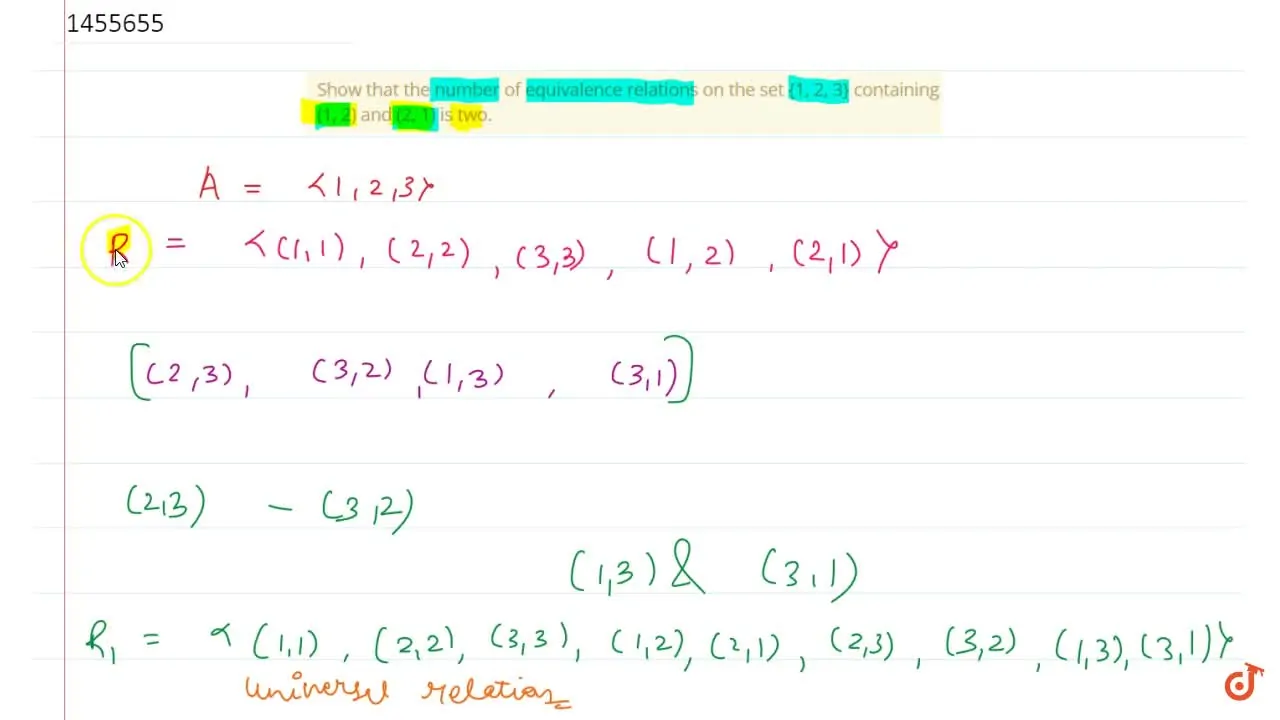Show that the number of equivalence relations on the set {1, 2, 3} containing (1, 2) and (2, 1) is two.
Total possible pairs ={(1,1),(1,2),(1,3),(2,1),(2,2),(2,3),(3,1),(3,2),(3,3)}
Reflexive means (a,a) should be in relation.
So, (1,1),(2,2),(3,3) should be in relation.
Symmetric means if (a,b) is in relation, then (b,a) should be in relation.
So, since (1,2) is in relation, (2,1) should also be in relation
Transitive means if (a,b) is in relation and (b,c) is in relation, then (a,c) is in relation.
So, if (1,2) is in relation and (2,1) is in relation, then (1,1) should be in relation.
Relation R1={(1,2),(2,1),(1,1),(2,2),(3,3)}
Total possible pairs ={(1,1),(1,2),(1,3),(2,1),(2,2),(2,3),(3,1),(3,2),(3,3)}
So, smallest relation is R1={(1,2),(2,1),(1,1),(2,2),(3,3)}
If we add (2,3)
then we have to add (3,2) also, as it is symmetric
but, as (1,2)&(3,2) are there, we need to add $(1,3)$ also, as it is transitive
As we are adding (1,3) we should add (3,1) also, as it is symmetric
Relation R2={(1,2),(2,1),(1,1),(2,2),(3,3),(2,3),(3,2),(1,3),(3,1)}
Hence, only two possible relation are there which are equivalence.
Related Playlists
Similar Questions
Show that the number of equivalence relation in the set {1,2,3}containing (1,2)and (2,1)is two.
View SolutionThe maximum number of equivalence relations on the set A={1,2,3} is
View SolutionThe maximum number of equivalence relations on the set A={1,2,3,4} are
View SolutionThe maximum number of equivalence relations on the set A = {1, 2, 3} are
View SolutionWrite the smallest equivalence relation on the set A={1, 2, 3} .
View SolutionThe maximum number of equivalence relations on the set A = {1,2,3,4} are
View SolutionLet A = { 1,3,5 } . then the number of equivalence relations in A containing (1,3) is ?
View SolutionThe maximum number of equivalence relations can be defined on the set A={1,2,3} are
View SolutionLet A={1,2,3}. Then number of equivalence relations containing (1, 2) is
(A) 1
(B) 2
(C) 3
(D) 4View SolutionThe relation in the set A = {1, 2, 3} given by R = {(2,3),(3,2),(1,1)} is:
View Solution


